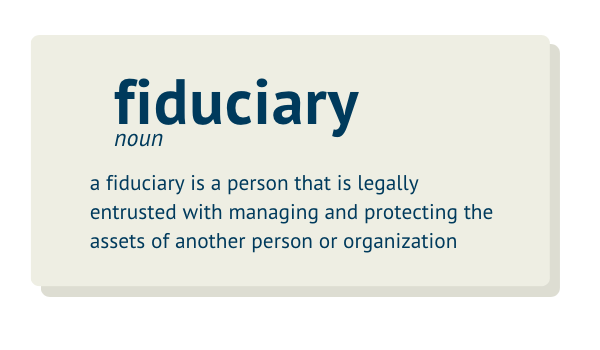What’s an ERISA Fiduciary?
January 25, 2023|Caleb White

Bottom Line Up Front
- An ERISA fiduciary is someone who manages or controls plan assets for an employer-sponsored retirement plan like pensions, 401(k)s, and profit-sharing plans or gives investment advice to the plan or participants of the plan.
- ERISA fiduciaries must uphold specific duties including acting in the best interest of plan members, acting prudently, diversifying plan assets, and following plan documents.
- With these obligations, it’s important to be prudent in staying compliant with the ERISA rules because you can be held liable for any losses or damages to the plan.
A fiduciary is a person that is legally entrusted with managing and protecting the assets of another person or organization. There are many different types of fiduciaries, but under ERISA, fiduciaries have discretionary control over a retirement plan and/or its assets and in turn, they must uphold a fiduciary duty. Translation – they have a legal duty to act in the best interests of the retirement plan, its plan sponsor, and its plan participants.

Employee Retirement Income Security Act (ERISA)
The Employee Retirement Income Security Act (ERISA) was enacted in 1974 and outlines rules to assure that retirement benefits are protected for workers in America. ERISA covers employer-sponsored retirement plans, such as pensions, 401(k)s, deferred compensation plans, and profit-sharing plans. The Act created the criteria that set a baseline for benefit accrual, eligibility, and plan funding.
ERISA aims to promote the interests of a retirement plan’s participants and beneficiaries by establishing fiduciary standards of conduct, responsibility, and obligations.
One can be an ERISA fiduciary if their authority or responsibilities dictate such under ERISA Section 3(21). ERISA fiduciary status is applied to someone if they:
- Have jurisdiction over the management of the plan
- Have control of the decision-making with the plan’s assets
- Has the ability to provide investment advice on plan assets
ERISA Fiduciaries Duties
Fiduciaries under the ERISA umbrella are required to follow certain duties to uphold their fiduciary standards:
Duty of Loyalty – The fiduciary is required to act in the best interest of the members of the plan, and to provide benefits to those plan members at a reasonable expense.
Duty to Act Prudently – Also known as the prudent man rule, this rule deems that fiduciaries must act in a way that is similar to the actions of a prudent person who has extensive knowledge of such situations.
Duty to Diversify Plan Assets – Fiduciaries that have jurisdiction over plan assets are obligated to diversify the plan’s investments in a way that minimizes the chance of large losses.
Duty to Follow Plan Documents – ERISA fiduciaries are required to act in accordance with the plan documents.
What Happens if an ERISA Fiduciary Breaches Their Duties?
If an ERISA Fiduciary breaches their duties, they may be held personally liable for any losses or damages suffered by the plan as a result of their actions or inaction. When a claim is made that a fiduciary has not met their fiduciary standards, there must be proof provided by the accuser to show that the fiduciary violated one of its fiduciary duties. Consequences of a breach of fiduciary duty can incur removal of fiduciary status, civil penalties, or in some cases, criminal prosecution.
Staying ERISA Compliant
It is important to be prudent to ensure that you and your company stay ERISA compliant. Knowing who in your organization is in a fiduciary role can help you manage your liability. Maintenance and familiarity with your Plan Document is a key step in remaining compliant with ERISA duties. Employers and companies often update benefit eligibility or other features, which can result in discrepancies in benefits provided versus the Plan Document, if the Plan Document is not properly updated.
Many plan sponsors are finding it challenging to manage their plans and remain in compliance with the requirements and any new legislation being adopted. It is crucial to provide a competitive retirement plan in the current market, and more and more plan sponsors are being tasked with fiduciary duties while managing their plans. Being aware of fiduciary responsibilities is extremely important in maintaining structure in a retirement plan.
How to Protect Yourself as an ERISA Fiduciary
As an ERISA fiduciary, you have a legal obligation to act in the best interests of the plan participants and beneficiaries. And as mentioned above, there are legal ramifications if a fiduciary breaches their duties. Here are some steps you can take to protect yourself as an ERISA fiduciary:
- Understand your duties and responsibilities: As an ERISA fiduciary, you have specific duties and responsibilities that must be upheld. Make sure you understand what they are and how to fulfill them.
- Follow the plan documents: The plan documents outline the rules and procedures for each retirement plan. You want to make sure that you reference and follow them as written (do not assume it’s the same as another plan on which you previously worked).
- Stay informed: Keep up-to-date with developments in ERISA and the IRS, such as investment and tax law. This will help you make informed decisions and avoid any mistakes.
- Seek advice: If you’re unsure about how to fulfill your duties or have questions regarding specific issues, you should seek advice from a qualified ERISA attorney or other experts.
- Document your actions: Keep careful records of all the actions you take as an ERISA fiduciary. This will help you demonstrate that you’ve fulfilled your duties and responsibilities.
- Exercise caution when selecting service providers: You are responsible for selecting and monitoring service providers, such as investment managers and plan administrators. Make sure you do your due diligence and select providers that have a track record of success.
- Avoid conflicts of interest: One of your responsibilities as a fiduciary is to avoid any conflicts of interest. This means not using your position to benefit yourself or others at the expense of the plan participants and beneficiaries.
- Follow the law: While this may seem like common sense, it is of the utmost importance. Make sure you follow all applicable laws and regulations, including ERISA and any state laws that apply to the plan.
4 Levels of Liability for ERISA Fiduciaries
In order to minimize some of the responsibilities ERISA fiduciaries must fulfill, they can exercise Fiduciary Governance. This typically involves establishing policies and procedures which help and guide the actions of fiduciaries, as well as ways to monitor and evaluate their performance.
One way is to appoint different people (who have the necessary experience) to the different levels of fiduciary liability. This will help alleviate the number of responsibilities one person is responsible for and ensure the plan is being properly managed. Fiduciary liability under ERISA is divided into four levels:
402(a) Named Fiduciary – Highest level of responsibility regarding the plan, includes all the responsibilities of the levels below.
3(16) Plan Administrator – In charge of divulging plan details and management of day-to-day reporting of plan changes.
3(21) Investment Advisor – Offers investment advice, but is not responsible for the actual investment of the plan’s assets. The Plan Sponsor can decide to follow the Investment Advisor’s advice, in which case the Plan Sponsor would take on the investment liability.
3(38) Investment Manager – Is responsible and has discretion over plan investments and assets. The Investment Manager also has partial liability along with the Plan Sponsor under ERISA, for investments only.
Other Examples of Fiduciary Guidance practices:
- Establishing policies and procedures to guide the actions of fiduciaries
- Appointing a governing board or committee to oversee fiduciary activities
- Establishing a process for selecting and monitoring service providers
- Providing training and education to fiduciaries on their duties and responsibilities
- Establishing a system for reporting and resolving conflicts of interest
- Conducting regular performance evaluations
By implementing any of these practices, you can ensure that the fiduciary duties are being fulfilled in a responsible manner and that the assets are being managed in the best interest of the beneficiaries.
Still Unsure?
The key is to stay proactive. It’s easier to avoid mistakes if you understand your duties, keep ahead of ERISA updates, and follow the steps above. And if you need advice or help carrying out the required responsibilities, you can schedule a plan review with one of our ERISA experts to ensure that you are administering your plan in accordance with the underlying plan document.
Categories: Retirement

About The Author Caleb is new to the actuary world. He specializes in assisting with designing and analyzing employee benefit programs with an emphasis on pension and post-retirement medical and insurance plans. Caleb grew up in Charlton, MA, and went to Worcester State...
More Insights From This author
